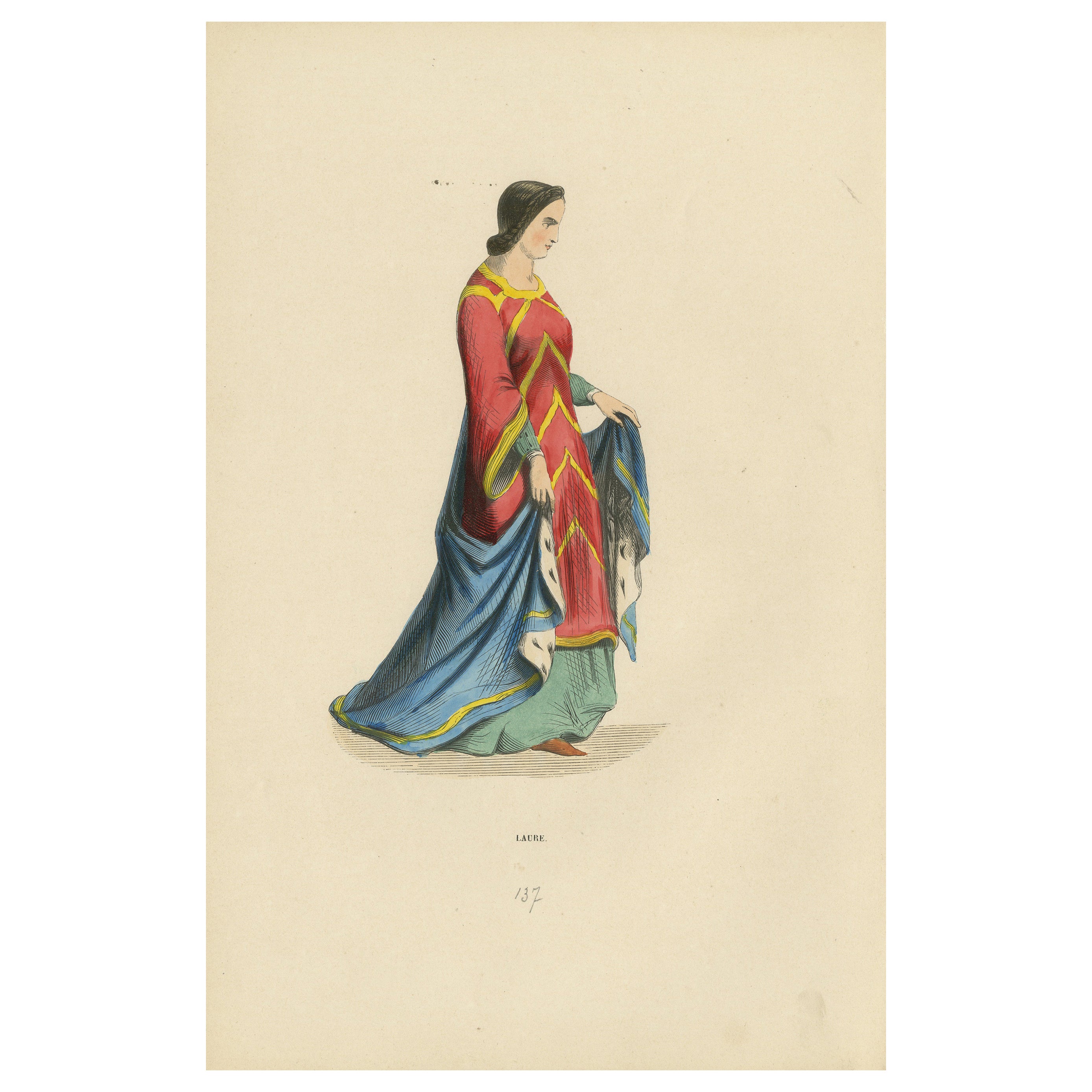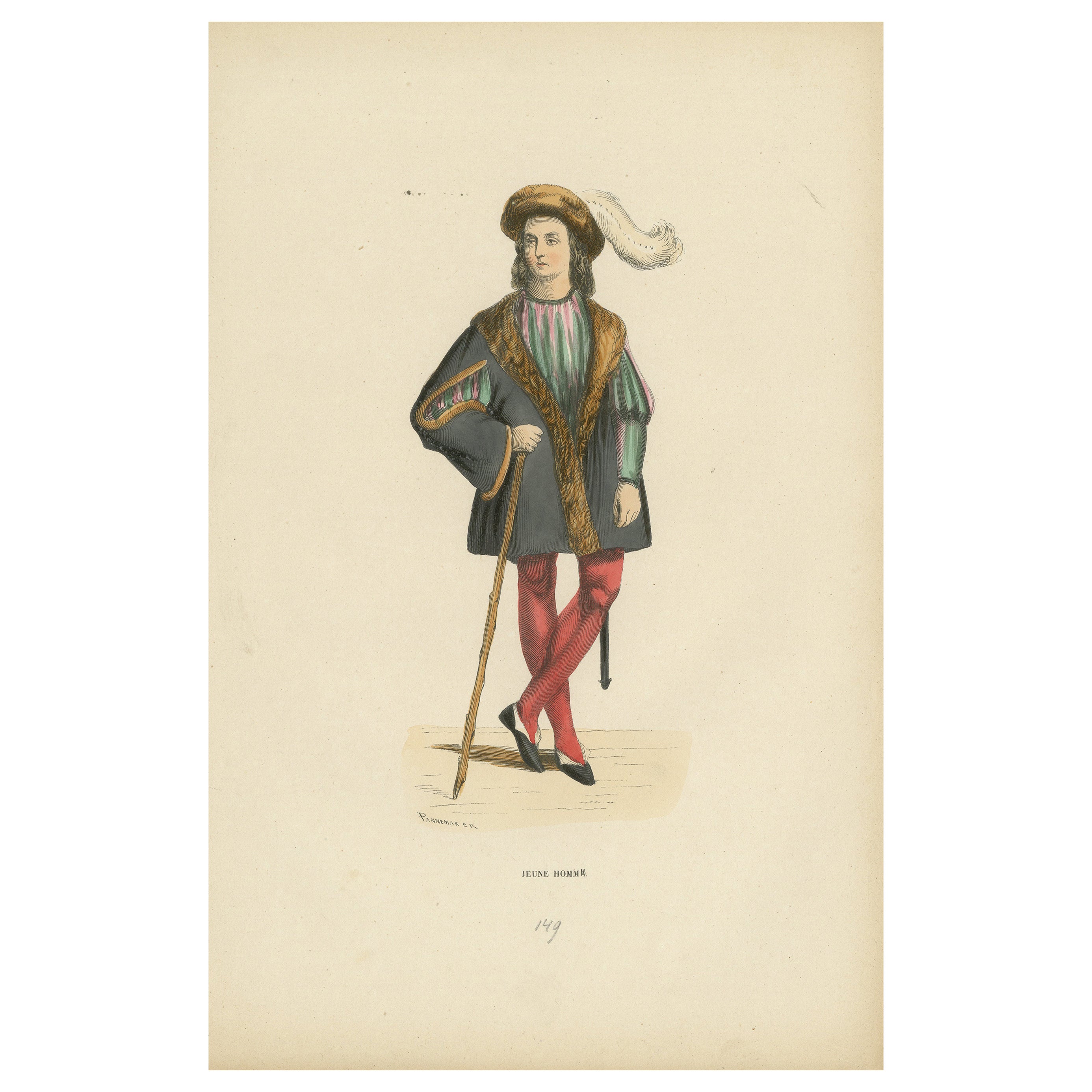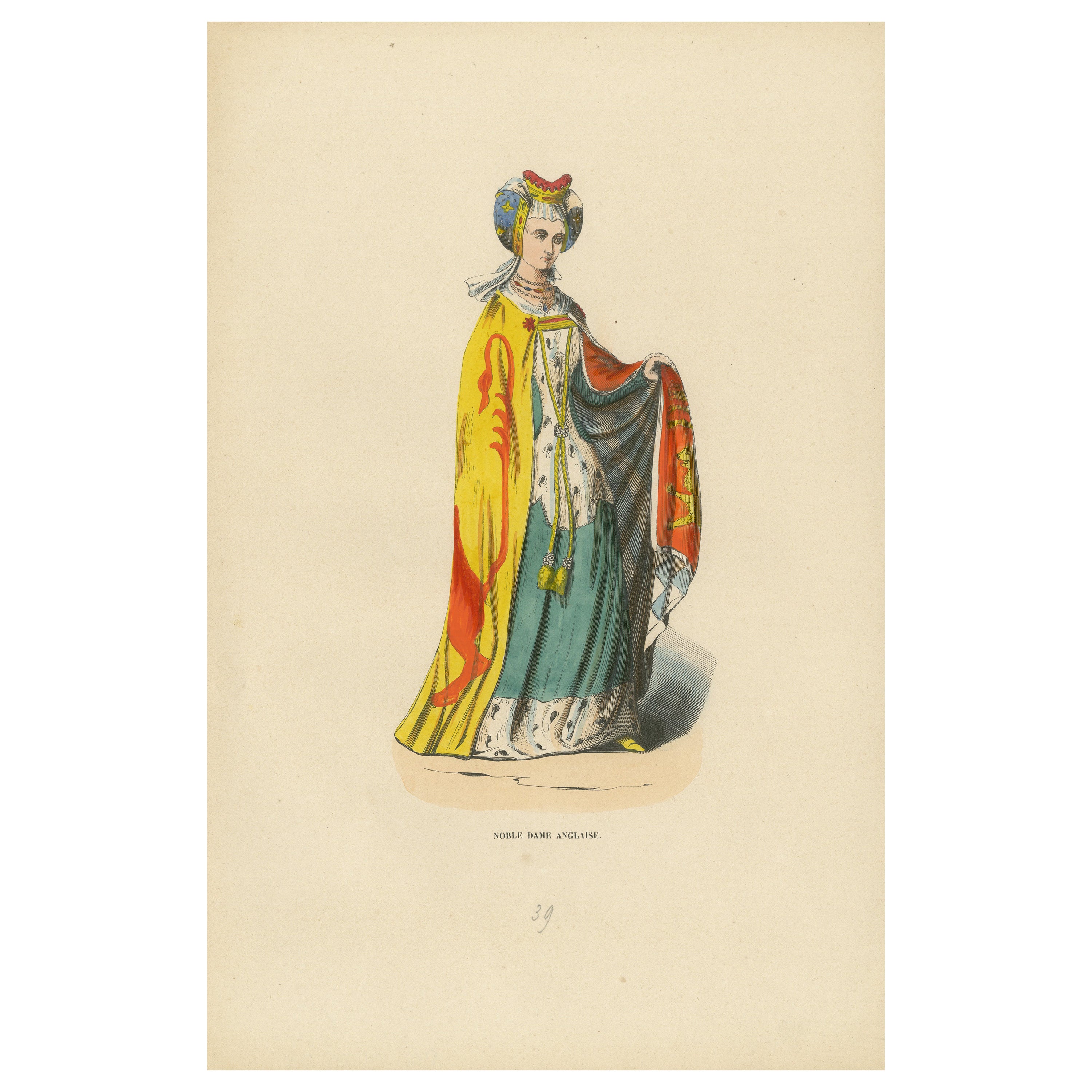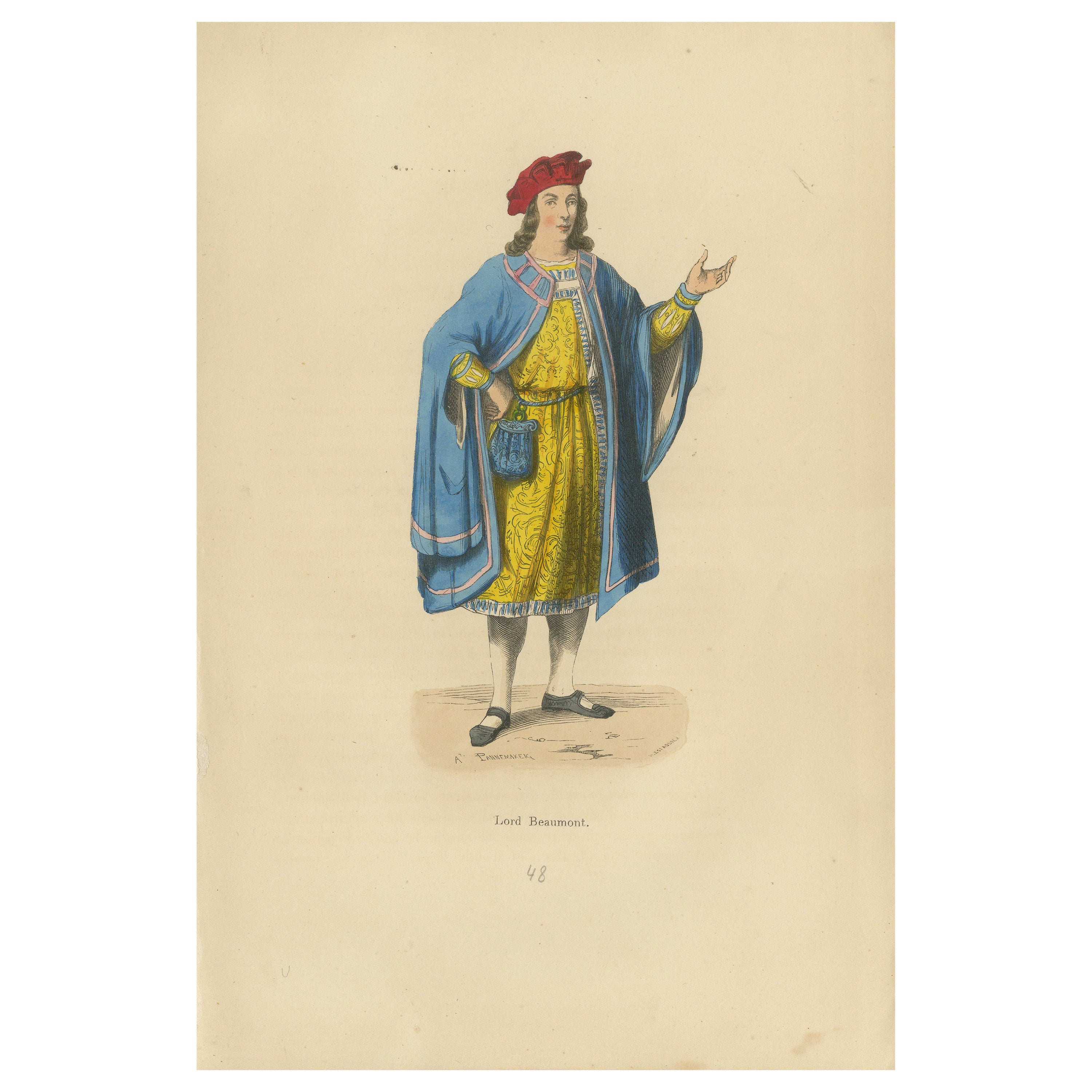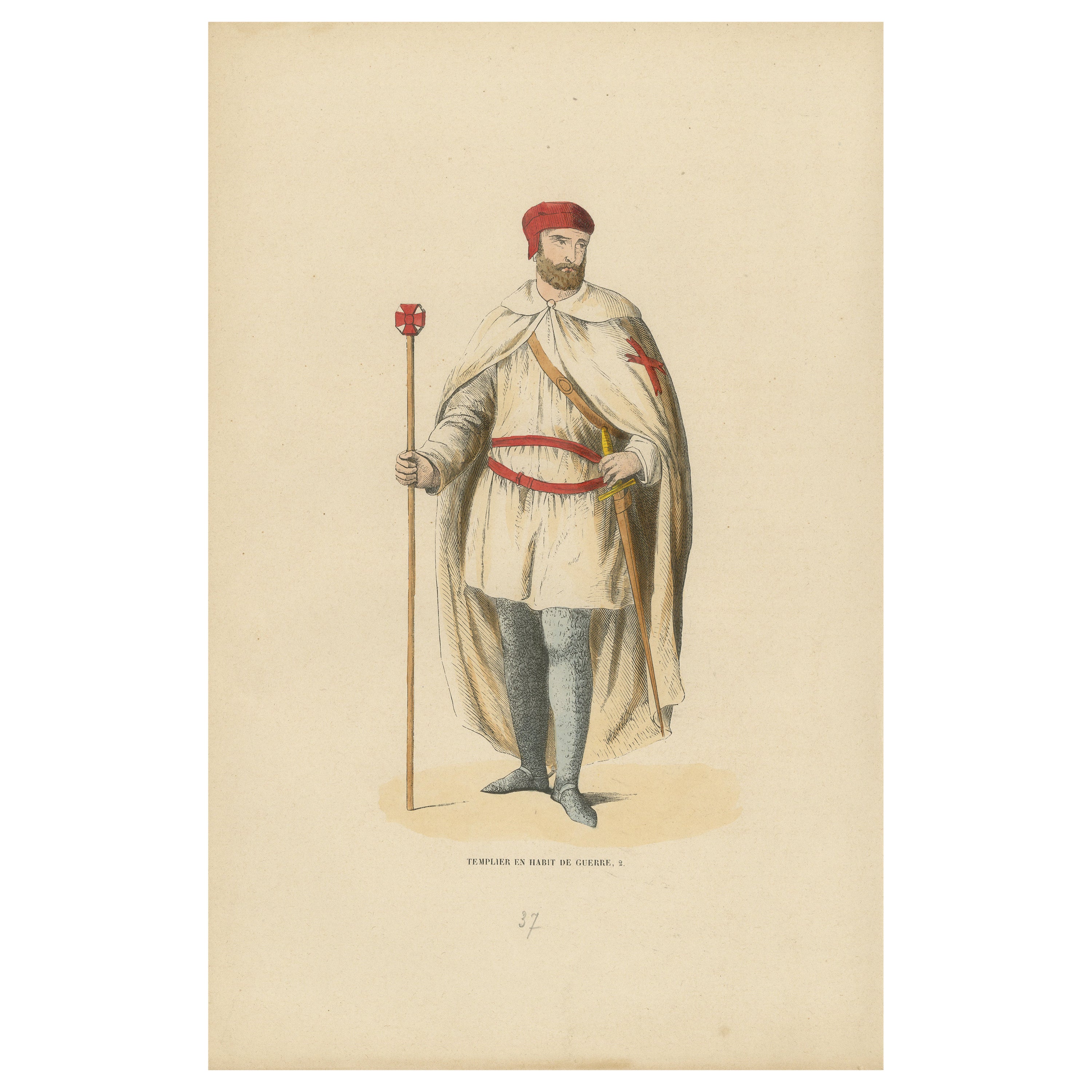Items Similar to The Mercenary's Garb: Armor and Attire in 'Costume du Moyen Âge, 1847
Want more images or videos?
Request additional images or videos from the seller
The Mercenary's Garb: Armor and Attire in 'Costume du Moyen Âge, 1847
About the Item
Title: "The Mercenary's Garb: Armor and Attire in 'Costume du Moyen Âge'"
Description: This lithograph from the "Costume du Moyen Âge" series, dated 1847, showcases the practical and robust attire of a mercenary from the Middle Ages. The illustration provides a rear view of the mercenary, emphasizing the protective elements of his armor. He is equipped with a metal helmet of conical shape, typical of the period for its straightforward construction and efficiency in deflecting blows.
His body is clad in a gambeson, a padded defensive jacket worn as armor, which is colored in a subdued shade of gold, signifying durability and the no-nonsense approach of a soldier-for-hire. Over the gambeson, he wears a hauberk of chainmail, providing a crucial layer of defense. The hauberk includes a coif that would protect the neck and shoulders.
Distinctive red accents are visible at the elbows, adding a touch of individuality to the otherwise utilitarian ensemble. The mercenary's lower attire consists of tight-fitting hose in a rich shade of green, allowing for flexibility and agility in movement, which are secured with decorative points at the waist.
Completing his attire are practical, sturdy shoes suited for marching and combat. In his hand, he holds a long spear, his weapon of choice, indicating his readiness for battle.
This image not only captures the typical military attire of a mercenary but also conveys the transient and often precarious life of a medieval soldier. The lithograph is a study in the fusion of function and form, illustrating the necessity of protection in warfare and the personal style of a professional warrior of the time.
The colors have a nice glow over them. Historically, egg whites, known as glair, and sometimes egg yolk were indeed used in illumination and painting, particularly in manuscripts, to give colors a brighter appearance and to add a sheen or gloss to the work. This technique was quite common during the Middle Ages and into the Renaissance.
Egg whites can be applied as a varnish over pigments to enhance their brightness and to protect the colors. This application could make the colors appear more vivid and also add a slight glossy sheen to the surface of the image.
Egg yolk, on the other hand, was commonly used as a binding agent in paint. It forms the basis of tempera paint, a medium that was widely used before the advent of oil painting. Egg yolk helps to create a durable and long-lasting color that adheres well to various surfaces.
In the context of the print from 1847, it's less likely that egg whites or yolks were used directly on the print, as by that time, commercial printing processes would have been more advanced and less reliant on such manual methods. However, if this print is a representation of an earlier style or is meant to mimic the appearance of hand-painted manuscripts, the original artists might have employed techniques or materials that gave a similar effect to those achieved with egg-based binders and varnishes.
- Dimensions:Height: 10.63 in (27 cm)Width: 7.09 in (18 cm)Depth: 0 in (0.02 mm)
- Materials and Techniques:
- Period:
- Date of Manufacture:1847
- Condition:Good. Overal light toning and light soiling but the image itself clean and hand-colored almost 200 years ago and still in expliciet colors. Aged paper with typically warm, yellowish-brown hue, mostly around the edges. Study the images carefully.
- Seller Location:Langweer, NL
- Reference Number:
About the Seller
5.0
Platinum Seller
These expertly vetted sellers are 1stDibs' most experienced sellers and are rated highest by our customers.
Established in 2009
1stDibs seller since 2017
1,956 sales on 1stDibs
Typical response time: <1 hour
- ShippingRetrieving quote...Ships From: Langweer, Netherlands
- Return PolicyA return for this item may be initiated within 14 days of delivery.
More From This SellerView All
- Renaissance Grace: A Lady's Attire in 'Costume du Moyen Âge', 1847Located in Langweer, NLTitle: "Renaissance Grace: A Lady's Attire in 'Costume du Moyen Âge'" Description: This lithograph from "Costume du Moyen Âge," dated 1847, captures the elegance and vibrancy of a l...Category
Antique 1840s Prints
MaterialsPaper
- Youthful Elegance: A Young Gentleman's Attire in 'Costume du Moyen Âge', 1847Located in Langweer, NLTitle: "Youthful Elegance: A Young Gentleman's Attire in 'Costume du Moyen Âge'" Description: This lithograph, part of the 1847 "Costume du Moyen Âge" series, depicts a young gentle...Category
Antique 1840s Prints
MaterialsPaper
- English Noblewoman in Traditional Attire, Costume Di Moyen Age, 1847Located in Langweer, NLThis print presents an English noblewoman from the Middle Ages, dressed in a luxurious gown that reflects her high status. She wears an elaborate headdress, which was fashionable among the upper classes during that era. Her dress is adorned with intricate patterns and heraldic motifs, suggesting her family's noble lineage. The cape, vibrant in color and decorated with a complex design, drapes elegantly over her shoulders, indicative of the elaborate styles of the medieval nobility. More about the vivid colors of this original hand-colored antique print: The colors have a nice glow over them. Historically, egg whites, known as glair, and sometimes egg yolk were indeed used in illumination and painting, particularly in manuscripts, to give colors a brighter appearance and to add a sheen or gloss to the work. This technique was quite common during the Middle Ages and into the Renaissance. Egg whites can be applied as a varnish over pigments to enhance their brightness and to protect the colors. This application could make the colors appear more vivid and also add a slight glossy sheen to the surface of the image. Egg yolk, on the other hand, was commonly used as a binding agent in paint. It forms the basis of tempera paint, a medium that was widely used before the advent of oil painting. Egg yolk helps to create a durable and long-lasting color that adheres well to various surfaces. In the context of the print from 1847, it's less likely that egg whites or yolks were used directly on the print, as by that time, commercial printing processes would have been more advanced and less reliant on such manual methods. However, if this print is a representation of an earlier style or is meant to mimic the appearance of hand-painted...Category
Antique 1840s Prints
MaterialsPaper
- Templar Knight in Battle Attire, Costume Di Moyen Age, 1847Located in Langweer, NLThis original handcolored lithograph depicts a Templar knight in full war attire, mounted on a galloping horse. The knight is armored, carrying a sword raised high, likely in a charg...Category
Antique 1840s Prints
MaterialsPaper
- Lord Beaumont in Courtly Attire, Costume Di Moyen Age, 1847Located in Langweer, NLThe image shows a figure labeled as "Lord Beaumont," depicted in medieval attire. He is wearing a blue overcoat with a fur trim and a gold-patterned undergarment that extends to his ...Category
Antique 1840s Prints
MaterialsPaper
- Templar in War Attire with Staff, Costume Di Moyen Age, 1847Located in Langweer, NLThis print illustrates a Templar in a more subdued war attire compared to the fully armored depiction in another image of this series. He stands upright, holding a staff topped with ...Category
Antique 1840s Prints
MaterialsPaper
You May Also Like
- Pair Russian Portraits in 18th Century GarbLocated in New York, NYPair Russian portraits in 18th century garb. Fine French hand coloured engravings of a Russian male and female in traditional late 18th century richly coloured and styled clothing an...Category
Antique Late 18th Century French Prints
MaterialsPaper, Giltwood
- Large Vintage Prop Print of Greco Roman Statue of Woman in Flowing GarbLocated in New York, NYThis interesting print was probably part of a scene for a film, or TV production. The subject is a classical statue of a woman in a flowing dress, holding a pitcher and a bowl. The p...Category
Mid-20th Century American Classical Greek Prints
MaterialsWood, Paper
- Original Antique Print of Lions and Tigers, 1847 'Unframed'Located in St Annes, LancashireGreat image of lions. Unframed. It gives you the option of perhaps making a set up using your own choice of frames. Lithograph after Cpt. Brown with original hand color. Pub...Category
Antique 1840s English Folk Art Prints
MaterialsPaper
- André Lhote, French Artist, Color Lithography, 'The Mechanical Age'Located in Copenhagen, DKAndré Lhote (1885-1962), French artist. Color lithography. "The Mechanical Age", mid-20th century. Visible dimensions: 58 x 44 cm. Signed. In good condition.Category
Mid-20th Century French Mid-Century Modern Prints
MaterialsOther
- Steel Engraving from the 19th Century “Le Depart Du Courier”Located in Saint-Ouen, FRSteel engraving from the 19th century “Le Depart Du Courier” dedicated to Madame le Marquise de Montesquieu Measures: H 44 cm, L 33.5 cm.Category
Antique 19th Century French Romantic Prints
MaterialsPaper
- Original Antique Print of Cats, 1847 'Unframed'Located in St Annes, LancashireGreat image of cats. Unframed. It gives you the option of perhaps making a set up using your own choice of frames. Lithograph after Cpt. brown with original hand color. Published,...Category
Antique 1840s English Folk Art Prints
MaterialsPaper
